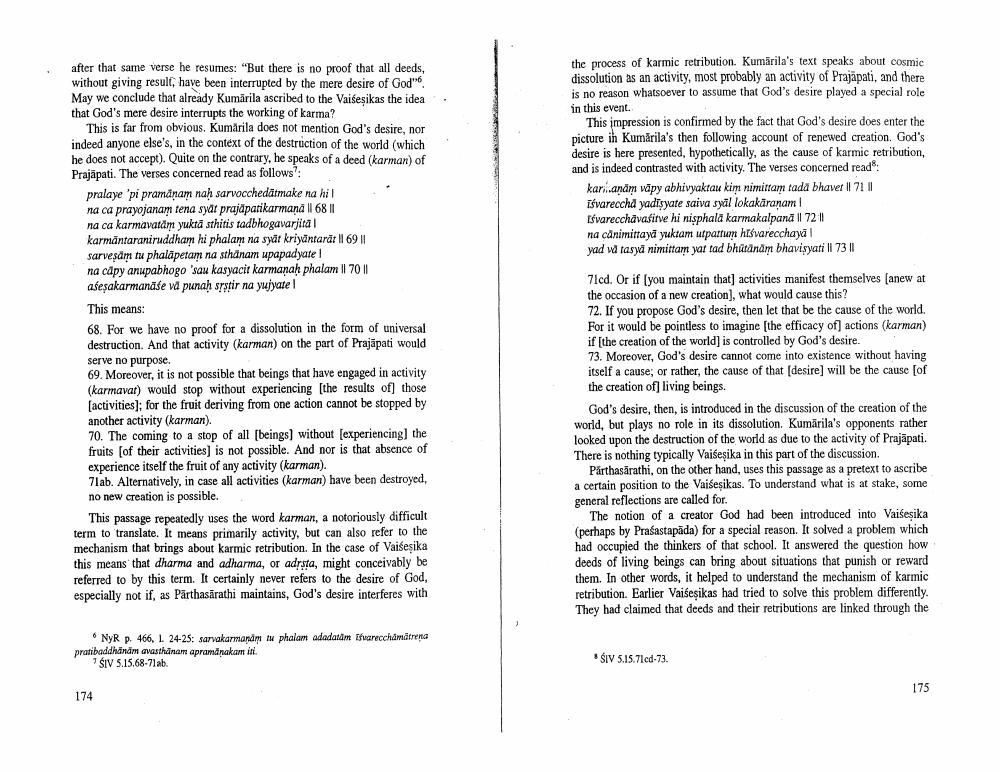Book Title: Mimamsa Versus Vaisesika Author(s): Johannes Bronkhorst Publisher: Johannes Bronkhorst View full book textPage 3
________________ . the process of karmic retribution. Kumärila's text speaks about cosmie dissolution as an activity, most probably an activity of Prajapati, and there is no reason whatsoever to assume that God's desire played a special role in this event. This impression is confirmed by the fact that God's desire does enter the picture in Kumarila's then following account of renewed creation. God's desire is here presented, hypothetically, as the cause of karmic retribution, and is indeed contrasted with activity. The verses concerned read: karianam wapy abhivyaktau kim nimittam tada bhaver || 71 | iśvarecchd yadisyate saiva syal lokakaranam ! Isvarecchavafirve hi nisphala karmakalpanā || 72 11 na canimittaya yuktam utpattum hrsvarecchaya yad wd tasya nimittam yar tad bhutanam bhavisyati || 73 || after that same verse he resumes: "But there is no proof that all deeds, without giving results have been interrupted by the mere desire of God". May we conclude that already Kumārila ascribed to the Vaišeşikas the idea that God's mere desire interrupts the working of karma? This is far from obvious. Kumarila does not mention God's desire, nor indeed anyone else's, in the context of the destruction of the world (which he does not accept). Quite on the contrary, he speaks of a deed (karman) of Prajāpati. The verses concerned read as follows': pralaye 'pi pramanam nah sarvocchedatmake na hil na ca prayojanam tena syat prajapatikarmana || 68 II na ca karmavatam yukta sthitis tadbhogavarjital karmäntaraniruddham hi phalam na sydr kriyantardt 1169 1 sarvesdm tu phalapetam na sthanam upapadyate! na cdpy anupabhogo 'saw kasyacit karmanah phalam |70 | aśeşakarmanāse va punah srstir na yujyate! This means: 68. For we have no proof for a dissolution in the form of universal destruction. And that activity (karman) on the part of Prajapati would serve no purpose. 69. Moreover, it is not possible that beings that have engaged in activity (karmavat) would stop without experiencing (the results of] those (activities); for the fruit deriving from one action cannot be stopped by another activity (karman). 70. The coming to a stop of all [beings without [experiencing the fruits (of their activities) is not possible. And nor is that absence of experience itself the fruit of any activity (karman). 71ab. Alternatively, in case all activities (karman) have been destroyed, no new creation is possible. This passage repeatedly uses the word karman, a notoriously difficult term to translate. It means primarily activity, but can also refer to the mechanism that brings about karmic retribution. In the case of Vaišeşika this means that dharma and adharma, or adrsta, might conceivably be referred to by this term. It certainly never refers to the desire of God, especially not if, as Pärthasarathi maintains, God's desire interferes with 71cd. Or if you maintain that) activities manifest themselves (anew at the occasion of a new creation], what would cause this? 72. If you propose God's desire, then let that be the cause of the world. For it would be pointless to imagine the efficacy of actions (karman) if (the creation of the world] is controlled by God's desire. 73. Moreover, God's desire cannot come into existence without having itself a cause, or rather, the cause of that (desire) will be the cause of the creation of living beings. God's desire, then, is introduced in the discussion of the creation of the world, but plays no role in its dissolution. Kumärila's opponents rather looked upon the destruction of the world as due to the activity of Prajapati. There is nothing typically Vaišeșika in this part of the discussion. Parthasarathi, on the other hand, uses this passage as a pretext to ascribe a certain position to the Vaišesikas. To understand what is at stake, some general reflections are called for. The notion of a creator God had been introduced into Vaišeşika (perhaps by Prasastapāda) for a special reason. It solved a problem which had occupied the thinkers of that school. It answered the question how deeds of living beings can bring about situations that punish or reward them. In other words, it helped to understand the mechanism of karmic retribution. Earlier Vaišeşikas had tried to solve this problem differently. They had claimed that deeds and their retributions are linked through the NyR p. 466. 1. 24-25: sarvakarmanăm tu phalam adadatam Ifwarecchâmātrena pratibaddhānām avasthanam apramanakam iri. 7 SIV 5.15.68-71ab. Śiv 5.15. 7cd-73. 175 174Page Navigation
1 2 3 4 5 6
